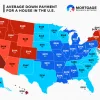Home Loans and Programs for First-Time Buyers

First-time homebuyers have access to a variety of loan options, down payment assistance programs, and government-backed resources to make homeownership more affordable. From low-down-payment conventional loans to state, federal, and nonprofit programs, there are many ways to reduce upfront costs and find the right mortgage for your needs.
Buying a home for the first time is an exciting milestone, but it can feel overwhelming, especially trying to understand the various mortgage options available. Fortunately, several home loans and programs are specifically designed for first-time buyers.
In this article, we’ll cover the range of options for first-time buyers, from low-down-payment loans to state and federal programs, along with resources to help you take the exciting first step toward owning a home.
Key Takeaways
First-time homebuyers have access to a variety of mortgage options, including both conventional and government-backed loans.
Programs offering down payment assistance or low-down payments can make homeownership more affordable.
Federal, state, nonprofit, and employer-sponsored programs offer additional support to help cover down payment and closing costs.
Eligibility requirements vary by program, so it’s important to research options that fit your unique financial situation.
Programs and Loans for First-Time Homebuyers
First-time homebuyers have access to a range of mortgage loans, including low down payment loans, down payment assistance, grants, and tax incentives.
Many of these programs offer benefits like help with your down payment as well as your closing costs. Some types of loans and programs available include:
Low-Down-Payment Conventional Loans: These loan programs offer smaller down payment options, making them ideal for first-time buyers. Conventional loans are worth considering due to their favorable terms and cost-effectiveness.
Low- or No-Down-Payment Government-Backed Loans: While not exclusive to first-time buyers, FHA, VA, and USDA loans are widely popular with first-time buyers. They offer options with minimal (and even zero) down payments, provided you meet eligibility requirements.
Down Payment Assistance Programs (DPA): Down payments are a significant hurdle for many homebuyers, but down payment assistance programs, often in the form of grants or low- to no-interest loans, can help reduce upfront costs—especially for first-time buyers.
Federal Programs for First-Time Buyers: Federal programs are available to U.S. citizens and legal residents. While eligibility varies by program, federal assistance is not restricted to residents of specific states. Federally-backed programs, including options for specific professions, can provide discounts or unique loan benefits.
State Programs: Many states offer home-buying assistance via their own first-time buyer programs. These programs often provide additional grants or low-interest loans and vary based on your location.
Nonprofit Programs: Charitable and nonprofit organizations offer educational and financial support to homebuyers with low-to-moderate incomes, typically setting income limits and specific eligibility criteria for assistance.
Employer-Sponsored Programs: Some employers offer homebuying assistance, typically in areas near their place of employment. These programs come in many forms, including down payment help and financial counseling.
Student Programs: Certain programs cater to recent graduates who may have student debt and need special assistance. These programs typically come with specific requirements, such as staying in a particular location for a given period for the funds to be forgivable.
Eligibility for First-Time Buyer Programs
To qualify for first-time buyer programs, you generally don’t need to be a first-time buyer in the strictest sense.
Most programs define first-time buyers as anyone who hasn’t owned a home in the last three years. However, these programs often include other eligibility requirements, such as income limits or geographic restrictions.
It’s important to review each program’s qualifications to determine eligibility and which program best suits your needs.
Low-Down-Payment Conventional Loans
Conventional loans, the most common home loan type, require a down payment as little as 3%, which makes homeownership more accessible for first-time homebuyers who may have limited savings for their down payment.
First-time homebuyer programs for conventional loans with low down payment options include:
Conventional 97 – The Fannie Mae Standard 97 is a great option for first-time homebuyers with a down payment requirement of only 3% and flexible guidelines that allow for various down payment sources. There aren’t any income limitations for this program, but qualifications include at least one mortgage borrower being a first-time homebuyer with a minimum credit score of 620.
HomeReady® – The HomeReady mortgage is another great Fannie Mae program with a down payment requirement of just 3%. To qualify, your income cannot exceed 80% of the median income in the area you plan to purchase. In addition to its low down payment option, the HomeReady loan has added flexibility on income sources, including the ability for non-occupant borrower’s income to be considered.
Home Possible® – Freddie Mac’s Home Possible loan is a great mortgage option for first-timers with very low-to low-income homebuyers. In addition to the low 3% down payment, Home Possible comes with reduced PMI (private mortgage insurance). While the Home Possible loan requires a higher minimum credit score (660) than the HomeReady loan, it also accommodates mortgage borrowers without a credit score due to limited credit history. However, this no-credit-score option requires a minimum down payment of 5%.
HomeOne® – Unlike Freddie Mac’s Home Possible loan, the HomeOne program has no income limits while still offering a minimum of 3% down, making it an accessible option for first-time buyers, especially homebuyers with higher incomes but low savings.
Government Home Loans with Low- and No-Down Payments
Government-backed loans are ideal for many first-time buyers due to their lower credit requirements and down payment options.
FHA Loans – With a minimum down payment of 3.5%, FHA loans are popular among first-time buyers. They have more relaxed credit requirements, making them accessible to those with less-than-perfect credit. FHA loans also have higher debt-to-income (DTI) ratio allowances than conventional loans. Check out our guide to FHA loans for more information.
VA Loans – VA loans, available to eligible Veterans, active-duty service members, and certain military-affiliated individuals, require no down payment or mortgage insurance and offer competitive interest rates. The Native American Direct Loan (NADL) is a unique VA program designed specifically for Native American Veterans, offering homeownership assistance on federal trust lands to buy, build, or improve a home.
USDA Loans – USDA loans, which also require no down payment, are designed for low- to moderate-income buyers in eligible rural areas. These loans often have lower rates than conventional loans. USDA loans come with affordable terms, making them an excellent option for those buying outside major metropolitan areas.
Down Payment Assistance Programs
Down Payment Assistance (DPA) programs help cover part or all of the down payment and sometimes the closing costs for first-time buyers.
DPA programs come in different forms:
DPA Loans – These loans help cover the down payment and are often repaid alongside the mortgage or forgiven over time. Also known as second mortgages, these loans are structured as either low-interest, no-interest, or forgivable loans.
Down Payment Grants – Down payment grants provide free funds to help cover your down payment and/or closing costs. These grants are generally aimed at low- to moderate-income borrowers, often defined as those earning no more than 80% of their area’s median income. Grants provide down payment funds that generally don’t need to be repaid.
Savings Match Programs – A savings match DPA program provides grant funds equal to the amount a person saves for a down payment. These matched funds can be applied toward both the down payment and closing costs of a home purchase, making it easier to reach down payment goals.
Down payment assistance can often be combined with other loans and programs to provide even more comprehensive support for homebuyers with limited down payment funds.
Government First-Time Homebuyer Programs
Various government programs cater to first-time homebuyers, providing additional benefits, financial support, or lower down payment requirements.
Federal Programs
The federal government offers several home-buying assistance programs for first-time buyers, including:
Good Neighbor Next Door – This HUD program offers a 50% discount on eligible homes for teachers, firefighters, police officers, and EMTs buying a home in a specific area, provided they live in the home for at least three years. Check out our guide to down payment assistance for teachers, police, firefighters, and veterans to learn more.
HomePath – Fannie Mae’s HomePath program allows homebuyers and investors to purchase properties repossessed by Fannie Mae following foreclosure, short sale, or forfeiture. HomePath properties are often available at lower prices, but they’re also sold in as-is condition. In some cases, Fannie Mae makes repairs to homes prior to offering them for sale.
HomePath Ready Buyer Program – Fannie Mae’s HomePath Ready Buyer program can help first-time buyers purchase a home with as little as 3% down by completing an online homeownership education course. You may even qualify for up to 3% in closing cost reimbursement.
Energy-Efficient Mortgage (EEM) – Often called a green mortgage, this loan product allows you to finance energy-efficient upgrades to your home under favorable terms. EEMs allow you to roll the cost of the upgrades into your mortgage or refinance to make eco-friendly and money-saving upgrades to your home.
Section 184 Loan – The Section 184 Indian Home Loan Program offers financing with low down payments for Native American and Alaska Native families, tribes, and tribal housing entities.
State Programs
Many states offer their own programs tailored to first-time buyers, often including down payment assistance, lower interest rates, or grants. Each state has its own eligibility criteria and benefits, so researching the options in your state can open doors to additional support.
You can view a complete list of state-specific buying resources on the HUD program page.
Nonprofit Programs
If you have a low-to-moderate income, you may be eligible for assistance from charitable or nonprofit organizations. These non-governmental groups provide educational and financial support to help you purchase a home.
Neighborhood Assistance Corporation of America (NACA) – NACA offers zero-down-payment loans and no-closing-cost mortgages to low- and moderate-income buyers without credit score requirements.
Habitat for Humanity – This well-known organization offers affordable homeownership options for eligible buyers, often requiring them to participate in building the home.
Employer-Sponsored Programs
Some employers offer home-buying assistance programs as part of their benefits package. These programs may include down payment assistance, low-interest loans, or financial counseling to make the home-buying process more manageable.
Large employers like college universities and hospitals sometimes offer these programs to attract and retain employees.
Student Programs
For recent graduates, there are special home-buying programs that take into account the challenges of student debt and early-career income limitations.
Some state and federal programs offer reduced down payment options, special financing, or assistance to help recent graduates become homeowners sooner.
Physician Loans
Physician loans are designed to help medical professionals buy homes before they have a long credit or financial history.
These loans often don’t require private mortgage insurance (PMI) and may offer low or zero down payment options, making it easier for doctors in the early stages of their careers to purchase a home.
Getting Started as a First-Time Homebuyer
Taking the first step toward homeownership can feel overwhelming, but with the right resources, it’s manageable. As a first-time homebuyer, you have access to a wide range of programs and loans that can make purchasing a home more affordable and achievable.
Start by reviewing the types of loans and programs covered here and consider which ones best fit your situation. Check with your lender or mortgage advisor for eligibility details and assistance applying.
Once you’ve selected a program that meets your needs, work on gathering documentation, such as proof of income, tax returns, and any other required materials.






